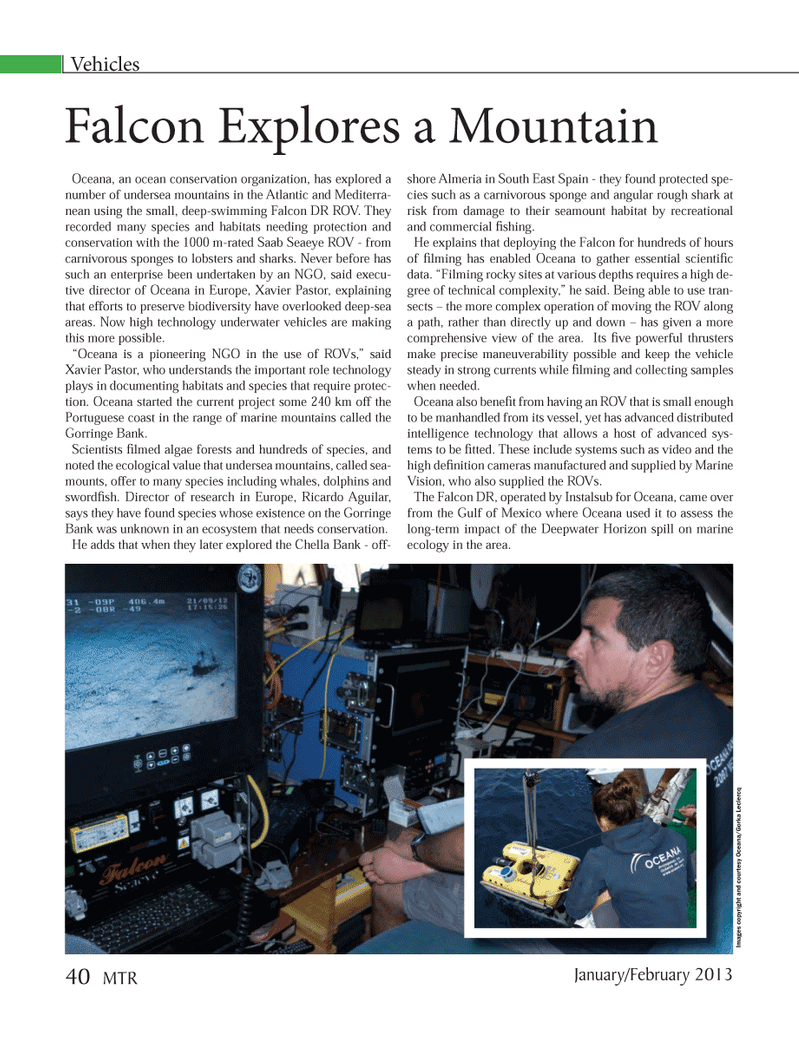
Page 40: of Marine Technology Magazine (January 2013)
Subsea Vehicle Report: Unmanned Underwater System
Read this page in Pdf, Flash or Html5 edition of January 2013 Marine Technology Magazine
Oceana, an ocean conservation organization, has explored a number of undersea mountains in the Atlantic and Mediterra- nean using the small, deep-swimming Falcon DR ROV. They recorded many species and habitats needing protection and conservation with the 1000 m-rated Saab Seaeye ROV - from carnivorous sponges to lobsters and sharks. Never before has such an enterprise been undertaken by an NGO, said execu- tive director of Oceana in Europe, Xavier Pastor, explaining that efforts to preserve biodiversity have overlooked deep-sea areas. Now high technology underwater vehicles are making this more possible.?Oceana is a pioneering NGO in the use of ROVs,? said Xavier Pastor, who understands the important role technology plays in documenting habitats and species that require protec-tion. Oceana started the current project some 240 km off the Portuguese coast in the range of marine mountains called the Gorringe Bank.Scientists lmed algae forests and hundreds of species, and noted the ecological value that undersea mountains, called sea- mounts, offer to many species including whales, dolphins and sword sh. Director of research in Europe, Ricardo Aguilar, says they have found species whose existence on the Gorringe Bank was unknown in an ecosystem that needs conservation. He adds that when they later explored the Chella Bank - off- shore Almeria in South East Spain - they found protected spe- cies such as a carnivorous sponge and angular rough shark at risk from damage to their seamount habitat by recreational and commercial shing.He explains that deploying the Falcon for hundreds of hours of lming has enabled Oceana to gather essential scienti c data. ?Filming rocky sites at various depths requires a high de- gree of technical complexity,? he said. Being able to use tran- sects ? the more complex operation of moving the ROV along a path, rather than directly up and down ? has given a more comprehensive view of the area. Its ve powerful thrusters make precise maneuverability possible and keep the vehicle steady in strong currents while lming and collecting samples when needed. Oceana also bene t from having an ROV that is small enough to be manhandled from its vessel, yet has advanced distributed intelligence technology that allows a host of advanced sys- tems to be tted. These include systems such as video and the high de nition cameras manufactured and supplied by Marine Vision, who also supplied the ROVs. The Falcon DR, operated by Instalsub for Oceana, came over from the Gulf of Mexico where Oceana used it to assess the long-term impact of the Deepwater Horizon spill on marine ecology in the area.Vehicles Falcon Explores a Mountain Falcon Explores a Mountain Images copyright and courtesy Oceana/Gorka Leclercq January/February 2013 40 MTRMTR #1 (34-49).indd 40MTR #1 (34-49).indd 401/30/2013 12:07:35 PM1/30/2013 12:07:35 PM

 39
39

 41
41
